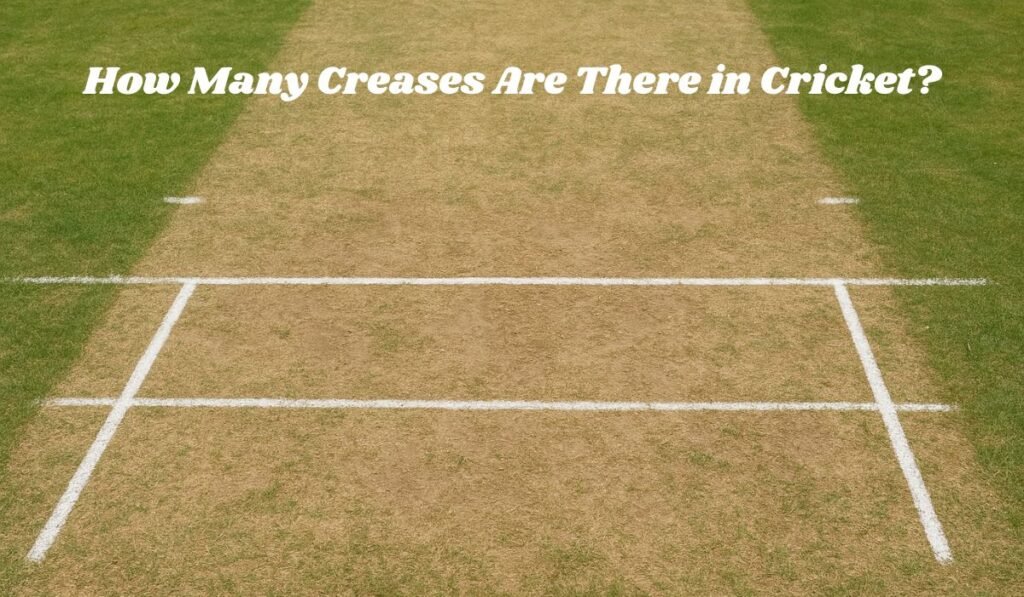Do you know how many creases are there in cricket? Well, the majority of the cricket fans always come up with the wrong number in answer to this question. There are eight creases in cricket, yes, eight. Don’t be surprised by the enormous number. Well, now you know that there are 8 creases in cricket, but do you know what each line means? You will see how they affect almost every ball that is played, whether it’s a no-ball or running out a batsman. In this guide, we’ll expound all that in the simplest way available – no jargon, no difficult cricket terminology, just straightforward explanations with examples which will make you understand the game better than ever before.
What is A Crease in Cricket?
A crease is a painted white line on the pitch that provides a boundary or means of setting off player actions. It’s useful, too.
Creases are the lines on the cricket pitch that run bowlers in their final delivery and batsmen when they are trying to score runs, as well as where actual decisions must be made.
This means that these lines are in effect invisible referees who keep the game honest and organized.
To put it more simply, it’s like playing tag-the crease is the “safe zone.” Once a batter gets into it, they can’t be tagged out (or, in cricket terms, run out).
How Many Creases Are There in Cricket?
There are in all eight creases in a standard cricket pitch – four at each end.
Here’s how the creases are arranged: the end.
- 2 Bowling Creases (1 at Each)
- 2 Popping Creases (1 at Each)
- 4 Return Creases (2 at Each End-One On Each Side Of The Stumps)
- In other words, there are 3 different kinds of crease and they are repeated at either end of the pitch-for a total of 8.
These eight simple lines control every crucial action: if a bowler’s delivery is legitimate, for example, if a batsman is safe; or indeed, it is a stumping by the wicket-keeper that counts against batsmen on strike.
Types of Creases in Cricket (Explained Simply)
The Bowling Crease
The crease – or ‘line’ – is the line on the pitch where the stumps are situated at both ends.
- Length: 8 feet 8 inches (2.64 meters).
- Direction: Runs horizontally across the pitch.
The bowling crease serves as the foundation of the pitch. It is the line on which the three stumps are set, so that every time you see a wicket fall, this is happening just above or on top of what we call the “crease.”
Bowlers:
When bowling, it is important for a bowler to keep behind this line from which he delivers the ball. If a bowler oversteps his mark and makes contact with the front edge of the crease (or marker indicating where else his foot can touch the ground), then it is called “no-ball.” This means an extra run for the batsman, sometimes even a free hit in limited-overs cricket.
Batters:
It helps them judge where the bowler’s delivery will come from and to position their stance accordingly. A batter who knows where the bowling crease is can also avoid putting too much weight on his back foot, which helps him play all of his shots better.
Fun Fact:
This crease has changed its use from time to time, but for centuries, since cricket began, it has been the reference point at which stumps are located.
The Popping Crease
Location: Drawn in parallel to the bowling crease, and exactly 1.22 metres (4 feet) in front of it.
Purpose: It defines one rear “safe zone” for the batters as well as the legal line of delivery for the bowlers.
If you can remember only one crease, let it be this one, for almost every climax in cricket is played out at or around the popping crease.
For bowlers:
They must land behind this line with their front foot when they deliver the ball. If not, the delivery is said to be a front-foot no-ball, which gives the batting team an enormous advantage.
For batters:
This line is their line between life and death. So long as any part of the bat or body is staying back in touch with earth that had been grounded behind the popping crease, they are “in.” Step over it and the wicket-keeper, or fielders, can destroy them instantly with a run-out or by stumping out (in the case of a batsman).
You have undoubtedly seen it on television. In a slow-motion replay, the batsman hurls themself to make it just inside the popping crease. This is what the popping crease is for!
Analogy:
Think of the popping crease as the home base in a game of tag – you’re safe when you’re inside it.
The Return Crease
Location: On each side of the stumps are two return creases, branching out parallel to the bowling crease.
Length: Extends a little in front and a little behind the bowling crease.
These vertical lines are often ignored by the casual viewer, but they are life and death for the bowler.
For bowlers:
If the back foot of a bowler goes on its way for delivery and sticks out over either of these lines, it’s a no-ball.
This rule stops bowlers from cutting strange corners or placing their feet so that the ball is bowled out too far away from the angle of the wicket, which might give them an unfair advantage.
In short:
- Keep your front foot behind the popping crease
- Keep your back foot inside the return creases
That’s how bowlers keep their delivery legal and how they keep their wickets!
A Glance at All 8 Creases
| Type | No. | Position | Role |
| Bowling Crease | 2 (1 each end) | Under the stumps | Defines wicket placement & delivery line |
| Popping Crease | 2 (1 each end) | 4 feet in front of stumps | Safety line for batters; no-ball line for bowlers |
| Return Crease | 4 (2 each end) | Perpendicular to bowling crease | Controls bowler’s back foot placement |
Why are Creases so Important in Cricket?
Without creases, the game would lose its structure completely. Imagine if bowlers could run in from anywhere or batters could stand where they liked – chaos, right?
Now let’s see why each crease is essential:
For Batters:
The popping crease determines whether they’re safe or out.
Helps them judge standing position so that before a bowler throws it to they can move from one side to another without stopping for explanation beyond being cheap filler words. Through at least part of his stride, he drives down under control and drops back.
For example, a stumped out or runout decision may ultimately turn on only two inches but those two inches may be the difference between victory and defeat, success or failure in this great game. It all happened because a man who can bend it just a little bit more than bowlers generally do
For Bowlers:
- Enforces their illegality by monitoring where they step over and cross the line.
- Their correct angle of delivery is preserved.
- Contributing to an effective posture when starting from ground zero really gives the run-up an impetus that helps promote rhythm, crucial in those early stages.
For Umpires:
- Provides clear visual reference points for making tough calls.
- Used to decide no-balls, run-outs, and stumpings.
- Makes the game standardized across every level – from local matches to the ICC World Cup.
Real-Life Examples Where Creases Change the Game
Can you believe it? The chirping of a cricket decides its match result. Strange Occurrences in Cricket That Can Only Happen on a Popping Crease:
1. MS Dhoni Run Out of Ross Tayler 2016
During the T20 game, Dhoni whipped off the bails just before Ross Taylor’s bat crossed the popping crease. The difference? Only an inch or two! It was a lesson in quick reflexes – with useful white lines. And of course, lightning cricket!
2. The Overstepping Incident with Ben Stokes
Even the world’s top players are not immune. In a Test match, Stokes delivered what appeared to be a wicket-taking ball, only for it to be called a no-ball because his front foot actually crossed the popping crease. The wicket didn’t count – a great example of how creases can change play flow.
3. Inch Matters, World Cup Finals 2019
England v New Zealand – a match that has gone down in history as one of the most thrilling. Every close run-out, every ball sent upstairs to check the replays on the giant screen had its supporters sitting literally on pins. That final demonstrated clearly how these thin white lines can settle cricket’s leading rewards.
The Emotional Side of The Crease
Cricket doesn’t consist solely of digits and rules-it’s made up of instinct, emotion, and inches.
To the batsman, taking centre feels like an accomplishment-it is safe ground to stand upon, somewhere still unharvested by any of his opponents.
To bowlers, standing outside of it is both discipline and special control.
And for spectators, that moment when the third umpire checks back to see if the bat made it over time, that’s an adrenaline rush, for which no amount of words is adequate.
The very heart and soul of the pitch is formed by the creases. Once you remove them, cricket loses not only its form but fairness and suspense as well in all senses of the word.
Final Thoughts
So now you know, how many creases does a cricket game have? In total, there are eight creases.
- 2 Bowling Creases
- 2 Popping Creases
- 4 Return Creases
Each one has a distinctive part to play in maintaining the balance, righteousness, and fun of the game.
Next time you go to a match, look at those white lines. These aren’t just marks on the ground; it’s what keeps cricket clean and thrilling.
Whether you’re a beginner (or know how to read the game), understanding creases provides a whole new layer of appreciation for our beloved one, just because further down the line.
Learn More:




